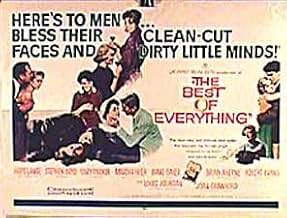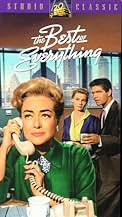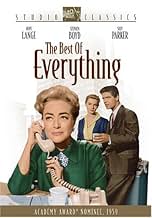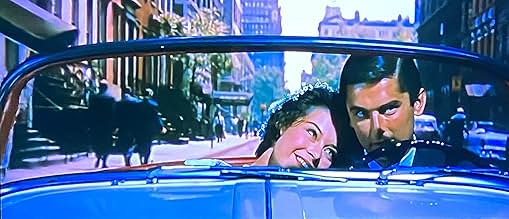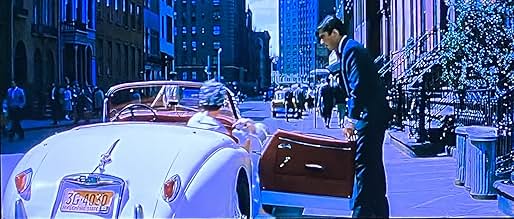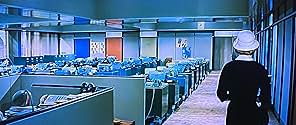AVALIAÇÃO DA IMDb
6,6/10
2,5 mil
SUA AVALIAÇÃO
Adicionar um enredo no seu idiomaAn expose of the lives and loves of Madison Avenue working girls and their higher ups.An expose of the lives and loves of Madison Avenue working girls and their higher ups.An expose of the lives and loves of Madison Avenue working girls and their higher ups.
- Direção
- Roteiristas
- Artistas
- Indicado a 2 Oscars
- 2 indicações no total
Linda Hutchins
- Jane
- (as Linda Hutchings)
Ted Otis Sr.
- Dr. Ronnie Wood
- (as Ted Otis)
Gertrude Astor
- Leading Woman in Play
- (não creditado)
Alan Austin
- Bill
- (não creditado)
Joseph Bardo
- Policeman
- (não creditado)
Avaliações em destaque
The Best of Everything is a high gloss large screen soap opera which follows the careers of four career women, Hope Lange, Suzy Parker, Diane Baker, and Martha Hyer at a New York publishing firm. What's the best for some women is not necessarily the best for all.
Presiding over this group of young fillies is wise old mare Joan Crawford who's been around the track a few times on screen and in real life. She looks right at home as the boss lady as well she should have at this point.
Around the time she was making The Best of Everything Joan Crawford became a widow when her fourth husband, Alfred Steele died. It was a particularly traumatic event for her, she woke up one morning and found him dead in bed next to her. She inherited all of his stock in Pepsi Cola where he was the board chairman and during the same period as The Best of Everything was being made, she wound up the queen bee at Pepsi Cola. Life does sometimes imitate art. So that authority as she barks out dictation and coffee orders to Hope Lange rings real true.
In fact all the women here with the exception of Lange are in for some rough sledding. It's rough for Lange too, but she literally makes the best of everything.
What a collection of stinkers the men are in this film. The best of them, Stephen Boyd, is a heavy drinker. The others Louis Jourdan, Robert Evans, and Brett Halsey, are as slimy a collection of rodents as ever gathered for one film.
I can't forget Brian Aherne either who's the fanny pinching head of this publishing firm. Half that office would have sexual harassment suits going today.
Some nice location shots of New York in the fifties make the film a real treat. Catch it by all means.
Presiding over this group of young fillies is wise old mare Joan Crawford who's been around the track a few times on screen and in real life. She looks right at home as the boss lady as well she should have at this point.
Around the time she was making The Best of Everything Joan Crawford became a widow when her fourth husband, Alfred Steele died. It was a particularly traumatic event for her, she woke up one morning and found him dead in bed next to her. She inherited all of his stock in Pepsi Cola where he was the board chairman and during the same period as The Best of Everything was being made, she wound up the queen bee at Pepsi Cola. Life does sometimes imitate art. So that authority as she barks out dictation and coffee orders to Hope Lange rings real true.
In fact all the women here with the exception of Lange are in for some rough sledding. It's rough for Lange too, but she literally makes the best of everything.
What a collection of stinkers the men are in this film. The best of them, Stephen Boyd, is a heavy drinker. The others Louis Jourdan, Robert Evans, and Brett Halsey, are as slimy a collection of rodents as ever gathered for one film.
I can't forget Brian Aherne either who's the fanny pinching head of this publishing firm. Half that office would have sexual harassment suits going today.
Some nice location shots of New York in the fifties make the film a real treat. Catch it by all means.
More equality today, much more, but overall nothing has changed. All the sad, tawdry, pathetic, moving and bitter moments between women and men in the office is just as it is today, less the blatant sexual harassment. Love looking at old pics of nyc and looking in store windows....things seem surprisingly familiar and not dated.
Caroline Bender (Hope Lange) is just killing time getting a job. Her real ambition is to marry Eddie and have a baby.
April (Diane Baker) is too innocent to stay that way for long and falls in love too easily, a dangerous combo.
Greg (Suzy Parker) is a go-getter and wants to be an actress.
All three are doomed for dramatics in 'The Best of Everything', a 1959 soap opera/morality play/sometimes solid movie that is aging by the second.
Set in the cut-throat world of paperback publishing, its not as trashy as "Valley of the Dolls" but not as vanilla as "Three Coins in the Fountain."
The men in the mix - Brian Aherne, Stephen Boyd, Louis Jourdan and Robert Evans - are slick, well-dressed and no good, for the most part. Aherne is the resident sexual offender - will pinch anything walking by, and makes unwanted advances right and left. His character is offensive as hell, but its not played seriously at all. Harassment hadn't been discovered yet, I guess. Boyd works there, too, although you never see him actually doing anything. He's too busy being older, wiser and drunker. Evans is abroad just so Diane Baker can suffer in style - he's a rich kid who's gotten her in 'trouble' so instead of marrying her, as promised, he's taking her to get an 'operation.'
Jourdan is a director who mistakenly has an affair with Parker. They share a fight scene which is fairly no-holds barred, in a movie like this anyway, but the scene is ultimately ruined by Parker's histronics. She ends up nearly stalking him, and she really didn't deserve such a lousy fate, her bad acting notwithstanding.
Joan Crawford breathes fire as Amanda Farrow, the resident 'witch' who is automatically rude and dismissive of any of her legion of secretaries. Well they are younger, aren't they? Isn't that sufficient reason to hate a person? Caroline doesn't think so, as she admirably stands up to Miss Farrow every chance she gets. Crawford only gets to let loose once, when she tells her married boyfriend 'you can your rabbit-faced wife can both go to hell' and slams down the phone. You never get to see the poor soul who dare crosses her.
Martha Hyer's 'storyline', as it were, is extremely weak, and she is painfully over-the-top as an unmarried mother. Short of wearing a huge "W" (for 'whore') on her cardigan, she walks around like a pathetic mess for most of her screen time. Even worse, she is not given the courtesy of having it all 'tied up', one way or the other, at the end. It won't matter that much, but still..
Its painfully obvious this all took place in a totally different world. People were nicer to one another for the most part and work was not a drag but something exciting, for a girl from outside NYC anyway.
One unconvincing drunk scene aside, Hope Lange helps it seem reasonably real as Caroline, who at least has more than one side to her character.
I admire that women are seen having an opinion, a chance and a choice. Not that its not wrapped in a nice bow, but it makes some points for equality. In 1959 that was probably noteworthy and possibly controversial. 7/10.
April (Diane Baker) is too innocent to stay that way for long and falls in love too easily, a dangerous combo.
Greg (Suzy Parker) is a go-getter and wants to be an actress.
All three are doomed for dramatics in 'The Best of Everything', a 1959 soap opera/morality play/sometimes solid movie that is aging by the second.
Set in the cut-throat world of paperback publishing, its not as trashy as "Valley of the Dolls" but not as vanilla as "Three Coins in the Fountain."
The men in the mix - Brian Aherne, Stephen Boyd, Louis Jourdan and Robert Evans - are slick, well-dressed and no good, for the most part. Aherne is the resident sexual offender - will pinch anything walking by, and makes unwanted advances right and left. His character is offensive as hell, but its not played seriously at all. Harassment hadn't been discovered yet, I guess. Boyd works there, too, although you never see him actually doing anything. He's too busy being older, wiser and drunker. Evans is abroad just so Diane Baker can suffer in style - he's a rich kid who's gotten her in 'trouble' so instead of marrying her, as promised, he's taking her to get an 'operation.'
Jourdan is a director who mistakenly has an affair with Parker. They share a fight scene which is fairly no-holds barred, in a movie like this anyway, but the scene is ultimately ruined by Parker's histronics. She ends up nearly stalking him, and she really didn't deserve such a lousy fate, her bad acting notwithstanding.
Joan Crawford breathes fire as Amanda Farrow, the resident 'witch' who is automatically rude and dismissive of any of her legion of secretaries. Well they are younger, aren't they? Isn't that sufficient reason to hate a person? Caroline doesn't think so, as she admirably stands up to Miss Farrow every chance she gets. Crawford only gets to let loose once, when she tells her married boyfriend 'you can your rabbit-faced wife can both go to hell' and slams down the phone. You never get to see the poor soul who dare crosses her.
Martha Hyer's 'storyline', as it were, is extremely weak, and she is painfully over-the-top as an unmarried mother. Short of wearing a huge "W" (for 'whore') on her cardigan, she walks around like a pathetic mess for most of her screen time. Even worse, she is not given the courtesy of having it all 'tied up', one way or the other, at the end. It won't matter that much, but still..
Its painfully obvious this all took place in a totally different world. People were nicer to one another for the most part and work was not a drag but something exciting, for a girl from outside NYC anyway.
One unconvincing drunk scene aside, Hope Lange helps it seem reasonably real as Caroline, who at least has more than one side to her character.
I admire that women are seen having an opinion, a chance and a choice. Not that its not wrapped in a nice bow, but it makes some points for equality. In 1959 that was probably noteworthy and possibly controversial. 7/10.
A classic late 50's film. The superannuated headliners (Joan Crawford and Louis Jordan) are not at their best, but the direction, cinematography, and acting of the younger cast are compelling. In a 50's sense (which I love).
The look and feel of the artsy (over-artsy?) contemporary film "Far from heaven" reflects exactly this sort of film (and I suspect this film may be one of the models). A silly plot, of course (hey, it's 1959!), but as a film-- glorious! As a reflection of the society, extremely interesting. And as witness to how Hollywood breaks away from the idealistic portrayal of American sexual mores, fascinating.
The look and feel of the artsy (over-artsy?) contemporary film "Far from heaven" reflects exactly this sort of film (and I suspect this film may be one of the models). A silly plot, of course (hey, it's 1959!), but as a film-- glorious! As a reflection of the society, extremely interesting. And as witness to how Hollywood breaks away from the idealistic portrayal of American sexual mores, fascinating.
I feel very strongly that this film was just like Waiting to Exhale with white females in the 1950's. As in Waiting to Exhale, all of the female characters got mixed up with men who were either married or no good. The only difference, besides the obvious, was that there wasn't much humor in this film. I would even say that it was tragic. Only one of the male characters seemed to be kind and sincere (Hope Lange's guy), but even then there was conflict in this relationship.
The story was about three young women who shared an apartment together and who had hopes and dreams of success. Unfortunately for them, romance didn't seem to come easy although they were young, intelligent and attractive. This movie could be called a tearjerker with the saddest part involving Suzy Parker's character whose obsession of an ex-boyfriend leads to tragedy.
This is a must see.
The story was about three young women who shared an apartment together and who had hopes and dreams of success. Unfortunately for them, romance didn't seem to come easy although they were young, intelligent and attractive. This movie could be called a tearjerker with the saddest part involving Suzy Parker's character whose obsession of an ex-boyfriend leads to tragedy.
This is a must see.
Você sabia?
- CuriosidadesJoan Crawford, recently elected to the board of directors of Pepsi after the death of her husband who had been President and CEO of the company, managed to swing a brief quasi product plug for the soft drink by having an unmistakable Pepsi machine (with the red, white, and blue Pepsi logo, but sans the word "Pepsi") installed in the secretaries' on-screen break room.
- Erros de gravaçãoIn the scene when Diane Baker tells Hope Lange "he's ten foot tall to me" while walking down the street, several people... two men and two young boys... look into the camera, smiling (they were obviously filming with a camera hidden in a car during these scenes as those people weren't extras).
- Citações
Amanda Farrow: Now you and your rabbit-faced wife can both go to hell!
- ConexõesFeatured in Playboy's Penthouse: Episode #1.1 (1959)
- Trilhas sonorasThe Best of Everything
by Sammy Cahn and Alfred Newman
Johnny Mathis sings during the opening credits
Also sung by a chorus at the end
Played often in the score
Principais escolhas
Faça login para avaliar e ver a lista de recomendações personalizadas
- How long is The Best of Everything?Fornecido pela Alexa
Detalhes
- Data de lançamento
- País de origem
- Idioma
- Também conhecido como
- Las audaces
- Locações de filme
- Empresas de produção
- Consulte mais créditos da empresa na IMDbPro
Bilheteria
- Orçamento
- US$ 2.500.000 (estimativa)
- Tempo de duração2 horas 1 minuto
- Cor
- Proporção
- 2.35 : 1
Contribua para esta página
Sugerir uma alteração ou adicionar conteúdo ausente

Principal brecha
By what name was Sob o Signo do Sexo (1959) officially released in India in English?
Responda

